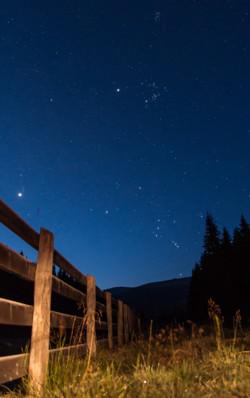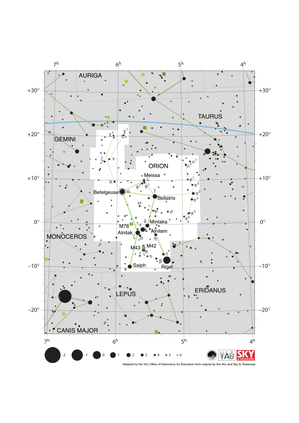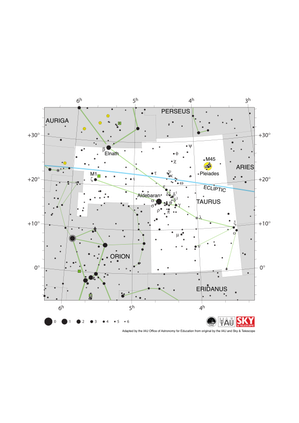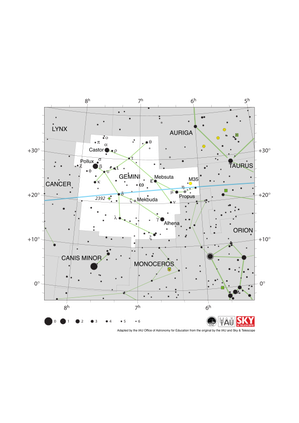Glossarbegriffe: Zwillinge
Description: Die Zwillinge (lateinisch Gemini) sind eines der 13 Sternbilder des Tierkreises und eines der 88 modernen Sternbilder, wie sie von der Internationalen Astronomischen Union definiert werden. Das Sternbild geht aber viel weiter zurück: Die Zwillinge waren bereits eines der 48 Sternbilder, die vom Astronomen Claudius Ptolemäus im 2. Jahrhundert beschrieben wurden. Das Sternbild hat seinen Namen von seinen beiden hellsten Sternen Castor und Pollux, die in der babylonischen Mythologie Zwillingsbrüder und Nebengötter waren. Die Zwillinge sind auf der Nordhalbkugel im Winter sichtbar und befinden sich zwischen den Sternbildern Stier und Krebs. Verschiedene Kulturen auf der ganzen Welt haben ihre eigenen Geschichten mit diesem Sternbild und seinen Sternen verbunden. Castor und Pollux befinden sich etwa 50 bzw. 30 Lichtjahre von der Erde entfernt. Etwa 80 Sterne im Sternbild Zwillinge können mit bloßem Auge gesehen werden. Einige bemerkenswerte Deep-Sky-Objekte in der Region dieses Sternbilds sind M35, NGC 2158, NGC 2392 und Abell 21.
Zugehörige Glossarbegriffe:
See this term in other languages
Term and definition status: The original definition of this term in English have been approved by a research astronomer and a teacher The translation of this term and its definition is still awaiting approval
The OAE Multilingual Glossary is a project of the IAU Office of Astronomy for Education (OAE) in collaboration with the IAU Office of Astronomy Outreach (OAO). The terms and definitions were chosen, written and reviewed by a collective effort from the OAE, the OAE Centers and Nodes, the OAE National Astronomy Education Coordinators (NAECs) and other volunteers. You can find a full list of credits here. All glossary terms and their definitions are released under a Creative Commons CC BY-4.0 license and should be credited to "IAU OAE".
If you notice a factual or translation error in this glossary term or definition then please get in touch.
Zugehörige Medien
Die hellsten Sterne am Himmel
Bildnachweis: Giorgia Hofer/IAU OAE
License: CC-BY-4.0 Creative Commons Namensnennung 4.0 International (CC BY 4.0) icons
Rumänischer Orion
Bildnachweis: Alex Conu/IAU OAE
License: CC-BY-4.0 Creative Commons Namensnennung 4.0 International (CC BY 4.0) icons
Die Geminiden-Feuerkugel
Bildnachweis: Jianfeng Dai/IAU OAE (CC BY 4.0)
License: CC-BY-4.0 Creative Commons Namensnennung 4.0 International (CC BY 4.0) icons
Related Diagrams
Orion Constellation Map
Bildnachweis: Adapted by the IAU Office of Astronomy for Education from the original by IAU/Sky & Telescope
License: CC-BY-4.0 Creative Commons Namensnennung 4.0 International (CC BY 4.0) icons
Taurus Constellation Map
Bildnachweis: Adapted by the IAU Office of Astronomy for Education from the original by IAU/Sky & Telescope
License: CC-BY-4.0 Creative Commons Namensnennung 4.0 International (CC BY 4.0) icons
Cancer Constellation Map
Bildnachweis: Adapted by the IAU Office of Astronomy for Education from the original by IAU/Sky & Telescope
License: CC-BY-4.0 Creative Commons Namensnennung 4.0 International (CC BY 4.0) icons
Gemini Constellation Map
Bildnachweis: Adapted by the IAU Office of Astronomy for Education from the original by IAU/Sky & Telescope
License: CC-BY-4.0 Creative Commons Namensnennung 4.0 International (CC BY 4.0) icons
Auriga Constellation Map
Bildnachweis: Adapted by the IAU Office of Astronomy for Education from the original by the IAU and Sky & Telescope
License: CC-BY-4.0 Creative Commons Namensnennung 4.0 International (CC BY 4.0) icons
















